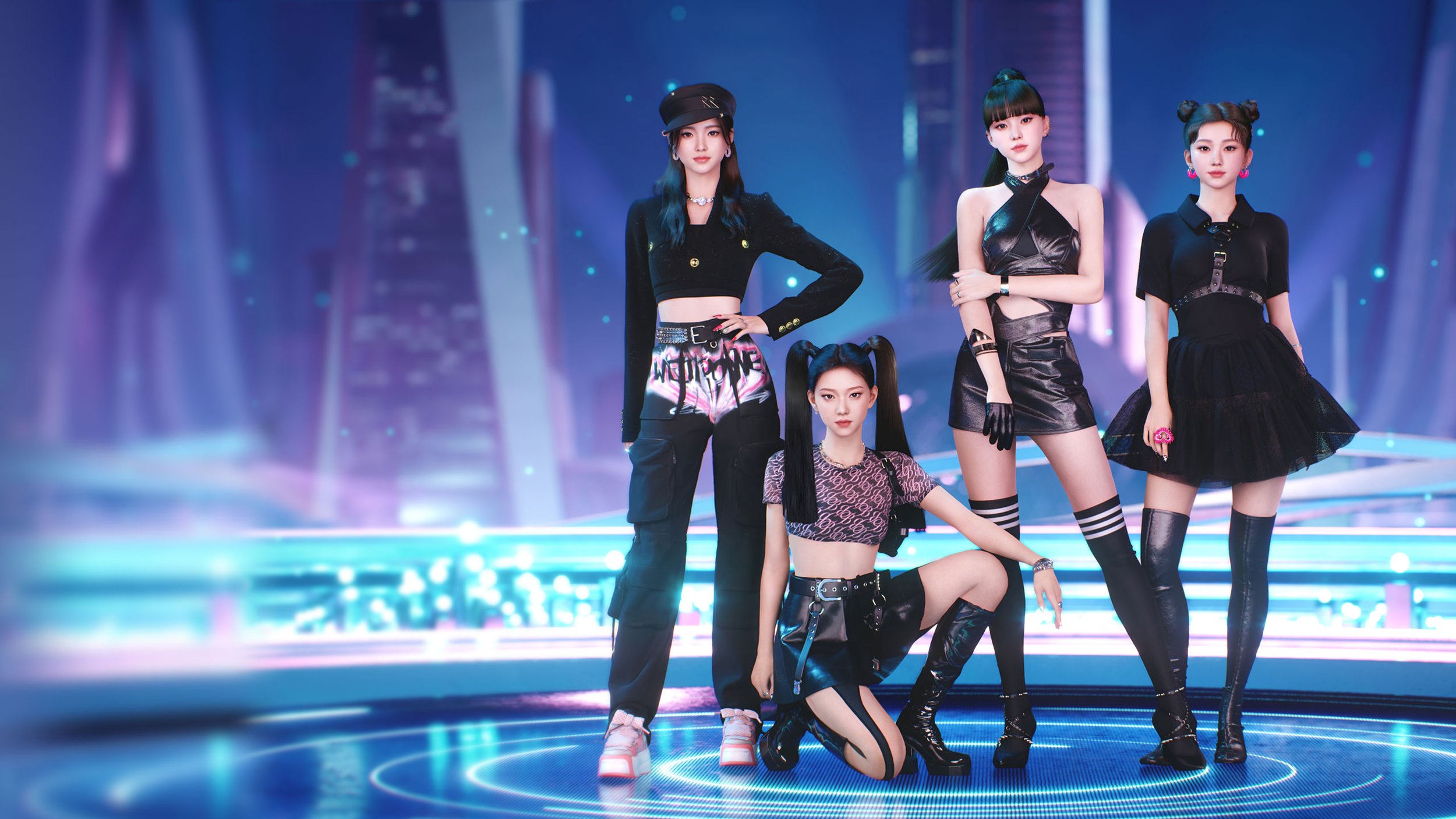Are AI idols the future of K-pop?
New technology means new K-pop concepts but are AI idols here to stay?
Digital idols are becoming more and more prevalent in modern K-pop. Image: SUPERKIND Official Twitter/X.
‘AI’ is the new technology buzzword that’s all over the internet. Artificial Intelligence generated art and chatbots are becoming much more accessible to anybody interested in using this new technology.
It’s a fresh way of exploring artistic expression, but many people are concerned about how using this technology negatively affects — and might eventually replace — artists, writers, and other creatives.
So what about AI in K-pop? Will ‘traditional’ idols eventually get replaced by virtual singers?
Defining an ‘AI Idol’
Idol groups with digital concepts are often lumped together in one category as ‘AI’, but there is a lot of nuance in how they’re using technology as part of their individual group identity. As a genre, K-pop loves to see what's new and often experiments with integrating fresh ideas and concepts. This means that different virtual idol groups all have individual interpretations of what digital idols are.
In reality, the use of AI in virtual idol groups is very scarce. So, if we want to look at what digital idols in the future could be like, we need to take a look at the few virtual idols who already exist in K-pop.
aespa
Promo picture from ‘Next Level’ era showing the aes with aespa. Image: SMTOWN.
When aespa debuted in 2020, SM Entertainment revealed the group’s unique digital concept. Karina, Giselle, Winter, and Ningning are the members of aespa, but there are also the ‘æ’ members who form æ-aespa. Each æ being a digital avatar of the aespa members.
GIANTSTEP Studios worked on a couple of æ-aespa’s music video appearances. According to their website, they “designed, created and rigged 4 alter egos for each member” of aespa “using performance motion capture.”
The æs aren’t actually generated by an artificial intelligence, just conceptually in aespa lore. In reality, they’re created by animators who based their work off the performances of the aespa members, and the creations are often placed under the AI umbrella. But æ-aespa don’t just appear in music videos, they’ve been showcased on performance stages too.
These performance appearances seemed to work differently to the music videos, as the æs are placed into reality and need to flow well with aespa’s dancing.
In this case, it seems like SM Entertainment hasn't yet committed to animating a whole æ-aespa performance stage. The æs rarely appear in aespa’s live performances and, a bit like boy group EXO’s exoplanet superpowers, the digital versions are used to enhance music video storytelling and give fans a narrative concept for them to theorise.
The æ-aespa members bolster the digital concept in a way that’s more like the cherry on top, rather than a fundamental part of their group identity. The æs don’t affect the human members’ performances or fan interactions; their role is primarily a supporting one.
If SM Entertainment stopped using æ-aespa, then aespa’s digital concept would probably be different. However, aespa’s day-to-day music releases, performances, and group dynamic wouldn’t be affected by no longer having digital members.
MAVE:
The four MAVE: members act to blend AI technologies with the style and sound of K-pop. Image: Metaverse Entertainment.
While aespa has both virtual and non-virtual members, MAVE: is a group composed solely of virtual idols. Created by Metaverse Entertainment, a subsidiary of South Korea’s biggest mobile gaming company Netmarble, MAVE: debuted in 2022.
The members of MAVE:, Siu, Zena, Tyra, and Marty, are partly AI generated. In an interview with El País, the Chief Technology Officer of Metaverse Entertainment Kang Sung-ku explained how MAVE: is created through a wide range of technological techniques, which include “machine learning, 3D modelling, various simulation techniques to control facial and body movements, augmented reality and virtual reality.”
Kang said the members have partly AI-generated voices, as the company uses a blend of real actor’s voices and AI-generated voices which are trained to speak as the actors do.
Unlike aespa, the digital idols of MAVE: are not based on real people but are unique creations of Metaverse Entertainment.
Speaking to South China Morning Post, Lee Gyu-tag, an associate professor of cultural studies at George Mason University Korea, said that virtual idol groups like MAVE: “will become something close to video technology, not K-pop.”
The fact that the members of MAVE: are completely manufactured and scripted by their company and have no unpredictability mean they are unable to connect with their fans on the same level as non-virtual groups.
PLAVE
PLAVE take ‘backstage’ photos at music broadcasts, just as other idol groups do. Image: PLAVE Official Twitter/X.
Although PLAVE may initially look like the members are partly AI-generated like MAVE:, they are virtual avatars who are completely created using motion capture technology.
Each member has one person behind him who sings and performs the choreography. The members are virtual avatars and so they are able to perform as their alter egos on live stages as well as online through live streams.
Through PLAVE’s mo-capped live streams, they can communicate with fans in real time, very similarly to V-tubers.
Cherry Chu spoke to the admins of the PLAVE INTL fanbase, who explained: “PLAVE stands out with a ‘manhwa’ style and ‘movie magic’ technology, featuring a real person controlling virtual selves.”
Fans are drawn to the group not only because of their digital concept but also to the idols’ personalities shown through their streams.
Due to their digital concept and mo-cap technology, they are usually unable to appear on variety shows like traditional idols, but through their live streams they participate in one of the most important aspects of being an idol: fan interaction. They upload frequently to their YouTube channel with English subtitles, where they can showcase the members’ personalities through informal content, such as playing horror video games.
PLAVE INTL also said that PLAVE’s “approach opens up new avenues for fan engagement and challenges the conventional expectations of what defines a K-pop group.” As the members perform via motion capture, their real identities and appearances are unknown.
Fans violating idols’ privacy is a big issue in the K-pop industry and it could be argued that separating identities from their idol personas, as PLAVE have, is an advantage for them. This means that fans are able to connect emotionally with the personalities of the idols through their digital avatars and the idols themselves are able to secure their privacy and keep their anonymity.
SUPERKIND
Two of the seven SUPERKIND members are digitally created for K-pop. Image: DEEPSTUDIO.
Different from the other groups in this article, SUPERKIND debuted in 2022 and features two digital idols who perform alongside the other members of the group.
They don’t shy away from the AI label for the virtual members but it’s not clear to what extent members Seung and SAEJiN use artificial intelligence, motion capture, 3D animation, or other technologies.
In the Show! Music Core performance below, the non-digital members of SUPERKIND leave space for the virtual members to perform and are able to dance alongside them. There’s much more of an attempted integration performance-wise between the digital and real idols compared to the other groups mentioned in this article.
SUPERKIND has not always been able to perform in such an integrated, innovative way. In fact, the majority of their performances and appearances so far have just featured the human members.
Some K-pop fans even feel like the concept of having both digital and human members in one idol group would leave the non-virtual idols feeling overshadowed.
In an interview with The Korea Times, the members of SUPERKIND recognised and explained the different roles between themselves and the digital idols.
Member SiO said: “We, the human members, tend to engage more in offline activities and maintain more direct interaction with our fans, while SAEJiN and Seung lean towards focusing more on engaging with our fans through online platforms. This is a means to draw a clear line between us and the virtual members, to emphasise the difference.”
We’ll have to see whether SUPERKIND’s blended digital/non-digital performances and separation of online and offline members will be sustainable for the group in the long run.
A world of ‘AIdols’?
Ultimately, the landscape of K-pop will likely continue to grow to include digital idols, although they might not become the norm. K-pop has always been a genre that tries to push technological and artistic boundaries, and digital idols are the new way of doing that. But it’s up to fans whether or not they’ll support a group and see their concept succeed.
There will always be more ‘traditional’ idol groups and new technology won’t change that. But maybe digital idol groups will exist alongside traditional K-pop groups in a similar way V-tubers and live-streamers do now.
I’m personally excited to see where the motion-capture technology goes and whether we’ll see more groups use it like PLAVE have in order to change the future of the K-pop world.
Edited by Gabii Rayner and Chelsea Cheetham.





